All Things
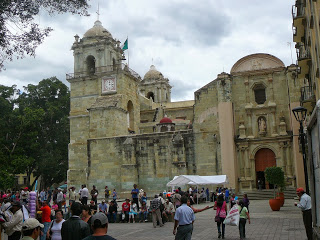 As far as I know there are not 12 gates (or any, actually, unlike, say, Florence), and it is not heaven by any means, but Oaxaca is quite something. The state of Oaxaca is very far south in Mexico, the south side of which borders on the Pacific. It is west of Chiapas where Guatemala and Central America attach. The city of Oaxaca is in its center, with mountains to the north and south. It is very Mexico but very different from the border and even the Yucatan further east. A colonial city with many beautiful old buildings, including the converted mansion we are now staying in two blocks east of the zócalo, Casa de Sierra Azul. It is a UNESCO world heritage city (see more later) and the zócalo is lined with restaurants and cafes, many on the second floor. Adjacent to it is the beautiful Cathedral, and several blocks north an even more impressive church, the Templo de Santo Domingo de Guzmán. Impressive, indeed, although it is hard to think about them and incredible amount of gold used in decoration without thinking of how many Indian lives it cost, to mine the gold and build the temples. There is a Plaza outside the Temple also, and many more through the city. The food is wonderful, Oaxacan cuisine based in large part on molés, red and green and, especially, black. Oaxacan chocolate (the unsweetened basis of the moles) is also ubiquitous. The city and the surrounding pueblitas are famous for their textiles (the Muséo de Textils is across the street) and their pottery – black from Coyotepec, green from Aztompa, etc. The most famous wool weaving are from Téotitlan del Valle, but there are others as well.
As far as I know there are not 12 gates (or any, actually, unlike, say, Florence), and it is not heaven by any means, but Oaxaca is quite something. The state of Oaxaca is very far south in Mexico, the south side of which borders on the Pacific. It is west of Chiapas where Guatemala and Central America attach. The city of Oaxaca is in its center, with mountains to the north and south. It is very Mexico but very different from the border and even the Yucatan further east. A colonial city with many beautiful old buildings, including the converted mansion we are now staying in two blocks east of the zócalo, Casa de Sierra Azul. It is a UNESCO world heritage city (see more later) and the zócalo is lined with restaurants and cafes, many on the second floor. Adjacent to it is the beautiful Cathedral, and several blocks north an even more impressive church, the Templo de Santo Domingo de Guzmán. Impressive, indeed, although it is hard to think about them and incredible amount of gold used in decoration without thinking of how many Indian lives it cost, to mine the gold and build the temples. There is a Plaza outside the Temple also, and many more through the city. The food is wonderful, Oaxacan cuisine based in large part on molés, red and green and, especially, black. Oaxacan chocolate (the unsweetened basis of the moles) is also ubiquitous. The city and the surrounding pueblitas are famous for their textiles (the Muséo de Textils is across the street) and their pottery – black from Coyotepec, green from Aztompa, etc. The most famous wool weaving are from Téotitlan del Valle, but there are others as well.
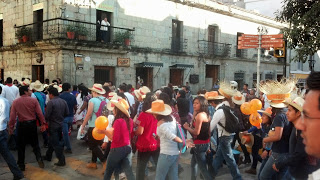 But for now, walking around the city! What a lost art in the US! Very few cities are walkable any more in the US, but the existence of historic “centers” still characterizes European and colonial Mexican cities, with plazas, courtyards, and places to sit and rest, as well as, of course, stores. Lots of them here, but most sell either the regular necessities of life (provided your life requires two shoe stores, zapatarias, per block!) or the crafts and foods of the region. Very few chains (mostly “Italian Coffee”, as ubiquitous as Starbucks on the Upper West Side of Manhattan, and apparently using Italian syrup not Oaxacan chocolate for their hot chocolate!) and none of the American ones. Frankly, I have not been in Guanajuato or Puebla and it has been a while since I was in Mérida, so I can’t compare the historic colonial center of Oaxaca to those, but it is very nice. They have closed a major street, Macedonio Alcalá, to traffic from the zócalo to the plaza of Santo Domingo, so it is a great place to stroll. Given that Oaxaca is a poor state, and that tourism is about 1/3 of the economy, it is an area that they want to focus on; were I an advisor to the city fathers, I’d suggest that it would be even more inviting to tourists if they’d close much more of the historic center to non-commercial traffic, say at least 2 blocks in every direction from the zócalo.
But for now, walking around the city! What a lost art in the US! Very few cities are walkable any more in the US, but the existence of historic “centers” still characterizes European and colonial Mexican cities, with plazas, courtyards, and places to sit and rest, as well as, of course, stores. Lots of them here, but most sell either the regular necessities of life (provided your life requires two shoe stores, zapatarias, per block!) or the crafts and foods of the region. Very few chains (mostly “Italian Coffee”, as ubiquitous as Starbucks on the Upper West Side of Manhattan, and apparently using Italian syrup not Oaxacan chocolate for their hot chocolate!) and none of the American ones. Frankly, I have not been in Guanajuato or Puebla and it has been a while since I was in Mérida, so I can’t compare the historic colonial center of Oaxaca to those, but it is very nice. They have closed a major street, Macedonio Alcalá, to traffic from the zócalo to the plaza of Santo Domingo, so it is a great place to stroll. Given that Oaxaca is a poor state, and that tourism is about 1/3 of the economy, it is an area that they want to focus on; were I an advisor to the city fathers, I’d suggest that it would be even more inviting to tourists if they’d close much more of the historic center to non-commercial traffic, say at least 2 blocks in every direction from the zócalo.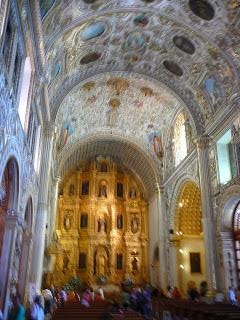 So walking around is great, however not completely hazard free. The beautiful slate paving stones on the sidewalks provide an uneven surface for the inattentive walker; they are also (typically) narrow and when a streetlight or mailbox or public phone (yes! There are public phones!) takes up half the width and a pair of people is going the other way, it can be a squeeze.
So walking around is great, however not completely hazard free. The beautiful slate paving stones on the sidewalks provide an uneven surface for the inattentive walker; they are also (typically) narrow and when a streetlight or mailbox or public phone (yes! There are public phones!) takes up half the width and a pair of people is going the other way, it can be a squeeze.
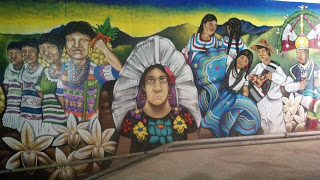 The conference certainly generated a major police presence; police, both municipal and state, patrolling on foot, in cars, and on trucks with machine guns mounted on every corner within several blocks of the zócalo. After the weekend, the end of the conference, the police presence dramatically decreased, but there was still an obvious presence in the streets of the historic centró. Other political activity continued in the zócalo, particularly a booth advocating for communal benefit, rather than privatization, of the nation and state’s oil resources. Also the zocálo and adjacent square outside the cathedral were full of stalls selling many goods – food, textiles, pottery – that had been apparently “cleaned up” for the UNESCO conference. In addition to the stalls, many individual vendors have returned.
The conference certainly generated a major police presence; police, both municipal and state, patrolling on foot, in cars, and on trucks with machine guns mounted on every corner within several blocks of the zócalo. After the weekend, the end of the conference, the police presence dramatically decreased, but there was still an obvious presence in the streets of the historic centró. Other political activity continued in the zócalo, particularly a booth advocating for communal benefit, rather than privatization, of the nation and state’s oil resources. Also the zocálo and adjacent square outside the cathedral were full of stalls selling many goods – food, textiles, pottery – that had been apparently “cleaned up” for the UNESCO conference. In addition to the stalls, many individual vendors have returned.
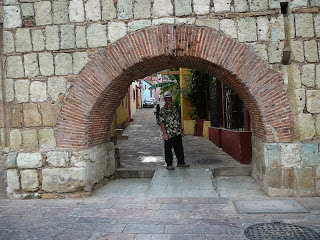
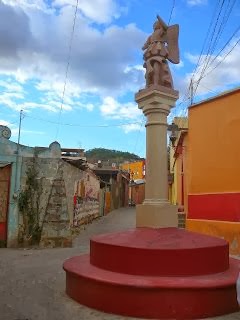 Stalls in the zócalo are small manifestations of the huge markets, Juárez two blocks away, and 20 de Noviembre, on the block beyond that. Also, to the north, the Mercado Pascua Sanchéz, with the huge fig tree in front. Near to that market is the escalera, section after section of steps lined with houses going up the hill toward the Guelaguetza arena at the top. But, before reaching the arena, in a covered area under the highway, a beautiful group of murals portraying history and music of the region. And, north of that, the small street of Rufino Tamyo lined with the arcos supporting the old aqueduct that brought water into Oaxaca from the foothills of the Sierra Juárez, and the village of San Felipe del Agua, now with stores and houses built into the arches, along with an occasional shrine and a small street guarded by a statue of the archangel Gabriel.
Stalls in the zócalo are small manifestations of the huge markets, Juárez two blocks away, and 20 de Noviembre, on the block beyond that. Also, to the north, the Mercado Pascua Sanchéz, with the huge fig tree in front. Near to that market is the escalera, section after section of steps lined with houses going up the hill toward the Guelaguetza arena at the top. But, before reaching the arena, in a covered area under the highway, a beautiful group of murals portraying history and music of the region. And, north of that, the small street of Rufino Tamyo lined with the arcos supporting the old aqueduct that brought water into Oaxaca from the foothills of the Sierra Juárez, and the village of San Felipe del Agua, now with stores and houses built into the arches, along with an occasional shrine and a small street guarded by a statue of the archangel Gabriel.
-
Occupy Wall Street! The Wall Street protests in New York City are entering their eighth week. During the early days you only heard about it on e-mail, from friends, from the Internet. The newspapers ignored it. But now the protests spread to other...
- Scandinavia Ii: Norway And Sweden
Oslo was great; not to denigrate Copenhagen, or Stockholm, but we liked it a lot. The Cathedral (a block from our hotel) is beautiful but small enough to be taken in and appreciated, kind of a shorthand for the whole city. There was an impressive exhibit...
- Santa Fe And The Pleasure Of Flat Hikes
Four days into my vacation at our recently built small house SE of Santa Fe, and hopefully getting into a pace where I spend less time on work email and more on sitting out on the east deck in the early morning cool, sipping coffee and watching the hummingbirds...
- Christmas In Tucson
It is colder than you might have thought, or at least might have wanted. When my son arrived almost at midnight on the 22nd, it was less than 35 degrees; maybe not much colder than what he left in Chicago, but he was hoping for tropical paradise. A couple...
- Steve Goodman
Writing about records has me thinking about music and performers. One of my favorites, possibly less well known all over the country than in his native Chicago, is the late Steve Goodman. He was a stalwart of the “folk revival” and author and singer...
All Things
“Oh, what a beautiful city!” (Oaxaca Part 1)
 But for now, walking around the city! What a lost art in the US! Very few cities are walkable any more in the US, but the existence of historic “centers” still characterizes European and colonial Mexican cities, with plazas, courtyards, and places to sit and rest, as well as, of course, stores. Lots of them here, but most sell either the regular necessities of life (provided your life requires two shoe stores, zapatarias, per block!) or the crafts and foods of the region. Very few chains (mostly “Italian Coffee”, as ubiquitous as Starbucks on the Upper West Side of Manhattan, and apparently using Italian syrup not Oaxacan chocolate for their hot chocolate!) and none of the American ones. Frankly, I have not been in Guanajuato or Puebla and it has been a while since I was in Mérida, so I can’t compare the historic colonial center of Oaxaca to those, but it is very nice. They have closed a major street, Macedonio Alcalá, to traffic from the zócalo to the plaza of Santo Domingo, so it is a great place to stroll. Given that Oaxaca is a poor state, and that tourism is about 1/3 of the economy, it is an area that they want to focus on; were I an advisor to the city fathers, I’d suggest that it would be even more inviting to tourists if they’d close much more of the historic center to non-commercial traffic, say at least 2 blocks in every direction from the zócalo.
But for now, walking around the city! What a lost art in the US! Very few cities are walkable any more in the US, but the existence of historic “centers” still characterizes European and colonial Mexican cities, with plazas, courtyards, and places to sit and rest, as well as, of course, stores. Lots of them here, but most sell either the regular necessities of life (provided your life requires two shoe stores, zapatarias, per block!) or the crafts and foods of the region. Very few chains (mostly “Italian Coffee”, as ubiquitous as Starbucks on the Upper West Side of Manhattan, and apparently using Italian syrup not Oaxacan chocolate for their hot chocolate!) and none of the American ones. Frankly, I have not been in Guanajuato or Puebla and it has been a while since I was in Mérida, so I can’t compare the historic colonial center of Oaxaca to those, but it is very nice. They have closed a major street, Macedonio Alcalá, to traffic from the zócalo to the plaza of Santo Domingo, so it is a great place to stroll. Given that Oaxaca is a poor state, and that tourism is about 1/3 of the economy, it is an area that they want to focus on; were I an advisor to the city fathers, I’d suggest that it would be even more inviting to tourists if they’d close much more of the historic center to non-commercial traffic, say at least 2 blocks in every direction from the zócalo. So walking around is great, however not completely hazard free. The beautiful slate paving stones on the sidewalks provide an uneven surface for the inattentive walker; they are also (typically) narrow and when a streetlight or mailbox or public phone (yes! There are public phones!) takes up half the width and a pair of people is going the other way, it can be a squeeze.
So walking around is great, however not completely hazard free. The beautiful slate paving stones on the sidewalks provide an uneven surface for the inattentive walker; they are also (typically) narrow and when a streetlight or mailbox or public phone (yes! There are public phones!) takes up half the width and a pair of people is going the other way, it can be a squeeze.But who cares! So much to see! So many places to try the molé! The zócalo is always great for strolling around, promenading. We saw two formal concerts there, one by a band of mostly young people that was more like song—45min interlude—song, so we didn’t stay for a lot of it; the other was the state marimba band, much more fun and exciting, with the interludes filled with digressions into the history of Oaxaca but the elderly (now wheelchair bound) man who directs it. One evening, we actually attended an indoor concert at the lovely Téatro Macedonio Alcalá. And even when no concerts, there is always interesting stuff happening. The first day we were there there was a demonstration in front of the municipal
palace that lines the southern side of the zócalo. The city was hosting a big meeting of the UNESCO “patrimonio” cities, and the demo seemed to be about the fact that while Oaxaca gets lots of money from UNESCO for this designation, the state is still very poor and the money is spent on – no one seems sure what. But not helping the poor.
 The conference certainly generated a major police presence; police, both municipal and state, patrolling on foot, in cars, and on trucks with machine guns mounted on every corner within several blocks of the zócalo. After the weekend, the end of the conference, the police presence dramatically decreased, but there was still an obvious presence in the streets of the historic centró. Other political activity continued in the zócalo, particularly a booth advocating for communal benefit, rather than privatization, of the nation and state’s oil resources. Also the zocálo and adjacent square outside the cathedral were full of stalls selling many goods – food, textiles, pottery – that had been apparently “cleaned up” for the UNESCO conference. In addition to the stalls, many individual vendors have returned.
The conference certainly generated a major police presence; police, both municipal and state, patrolling on foot, in cars, and on trucks with machine guns mounted on every corner within several blocks of the zócalo. After the weekend, the end of the conference, the police presence dramatically decreased, but there was still an obvious presence in the streets of the historic centró. Other political activity continued in the zócalo, particularly a booth advocating for communal benefit, rather than privatization, of the nation and state’s oil resources. Also the zocálo and adjacent square outside the cathedral were full of stalls selling many goods – food, textiles, pottery – that had been apparently “cleaned up” for the UNESCO conference. In addition to the stalls, many individual vendors have returned.
-
Occupy Wall Street! The Wall Street protests in New York City are entering their eighth week. During the early days you only heard about it on e-mail, from friends, from the Internet. The newspapers ignored it. But now the protests spread to other...
- Scandinavia Ii: Norway And Sweden
Oslo was great; not to denigrate Copenhagen, or Stockholm, but we liked it a lot. The Cathedral (a block from our hotel) is beautiful but small enough to be taken in and appreciated, kind of a shorthand for the whole city. There was an impressive exhibit...
- Santa Fe And The Pleasure Of Flat Hikes
Four days into my vacation at our recently built small house SE of Santa Fe, and hopefully getting into a pace where I spend less time on work email and more on sitting out on the east deck in the early morning cool, sipping coffee and watching the hummingbirds...
- Christmas In Tucson
It is colder than you might have thought, or at least might have wanted. When my son arrived almost at midnight on the 22nd, it was less than 35 degrees; maybe not much colder than what he left in Chicago, but he was hoping for tropical paradise. A couple...
- Steve Goodman
Writing about records has me thinking about music and performers. One of my favorites, possibly less well known all over the country than in his native Chicago, is the late Steve Goodman. He was a stalwart of the “folk revival” and author and singer...
